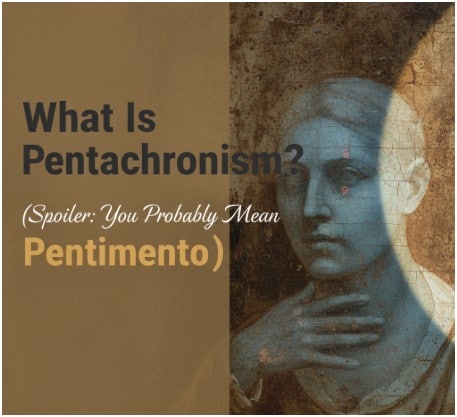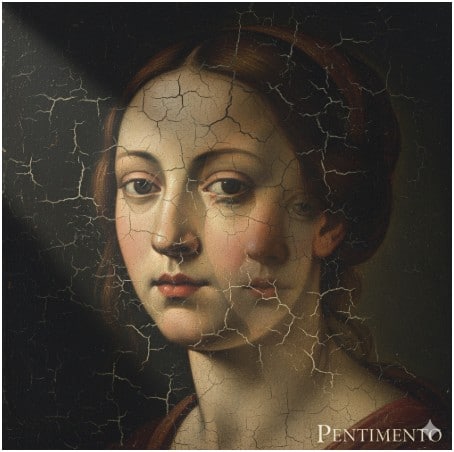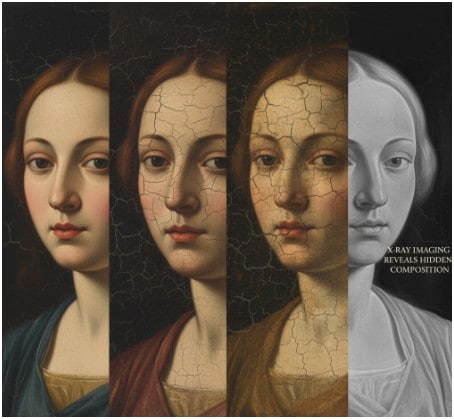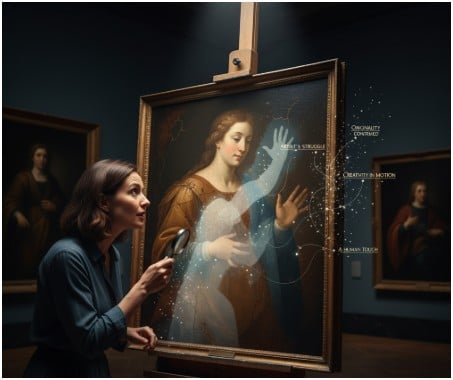Now Reading: What Is Pentachronism? (Spoiler: You Probably Mean Pentimento)
-
01
What Is Pentachronism? (Spoiler: You Probably Mean Pentimento)
What Is Pentachronism? (Spoiler: You Probably Mean Pentimento)

I still remember standing in front of The Old Guitarist by Pablo Picasso in a quiet gallery, my breath caught not by the painting’s somber beauty but by the faint outline of another figure hidden beneath. It felt like a secret whispered through time.
Later, when a friend casually mentioned the word pentachronism to describe it, I smiled—because I knew what they were really looking for: Pentimento.
Pentachronism isn’t a term in art history. The correct word is pentimento, and understanding it can open your eyes to an artist’s most human moments—their hesitations, revisions, and bursts of inspiration mid-creation.
What Does Pentimento Actually Mean?

A pentimento (plural: pentimenti) is a visible trace of an earlier painting layer that an artist later changed.
As the top layers of oil paint age, they can become more transparent, letting the original lines and shapes peek through.
The word comes from the Italian pentirsi, meaning “to repent,” and it perfectly describes an artist’s decision to rethink part of their work.
Unlike a mistake covered up forever, a pentimento reappears, like a ghost of the artist’s earlier vision.
Seeing one always makes me feel like I’ve been let in on a secret—a glimpse of the creative process frozen in time.
How Does a Pentimento Form?

Oil paint might look permanent, but it has a living quality. Over decades or centuries, it shifts and thins.
When an artist paints over an earlier design, the fresh paint conceals it for a time. But as the years pass, that newer layer can grow translucent, revealing the old strokes beneath.
Modern technology like X-ray imaging and Infrared reflectography has made spotting pentimenti much easier.
Even when they aren’t visible to the naked eye, these tools can detect hidden outlines and brushstrokes.
To me, this is where science and art shake hands. It’s thrilling when an X-ray uncovers something even the painting’s owner never knew was there.
Why Do Pentimenti Matter So Much?

Pentimenti are more than cool art trivia—they carry real cultural and historical weight. They prove that the painting you’re looking at is an original, not a copy.
Why? Because copyists don’t improvise. They reproduce what they see, line for line. Only the original artist makes mid-process changes.
They also tell stories about an artist’s mind at work. Each hidden hand or shifted face is a sign of struggle, reconsideration, and creativity in motion. It reminds me that even geniuses like Leonardo da Vinci and Jan van Eyck second-guessed themselves.
In a way, pentimenti are tiny confessions—“I thought this would work better”—and that vulnerability makes the artwork even more human.
Which Famous Paintings Show Pentimenti?
Some of the most celebrated paintings carry these hidden revisions. Once you know about them, you can’t help but feel like an insider every time you see one.
- The Old Guitarist by Pablo Picasso (1903): X-rays revealed a seated woman beneath the guitarist figure, almost like a memory haunting the painting.
- Arnolfini Portrait by Jan van Eyck (1434): Infrared scans show that the bride’s face was once higher, and the groom’s hands and feet were in different spots.
- Salvator Mundi (attributed to Leonardo da Vinci): The figure’s right thumb originally pointed another way before Leonardo reworked it.
- Flora by Rembrandt (1654): Look closely at her hat—there’s a second brim ghosting through where he repainted it.
Every time I discover a new pentimento in a famous painting, it feels like meeting the artist halfway across the centuries, in the middle of their “oops” moment.
How Is a Pentimento Different from a Palimpsest?
People often mix these two up, so here’s a quick comparison:
| Feature | Pentimento | Palimpsest |
| Medium | Painting | Manuscripts or parchments |
| Cause | Artist painted over an earlier design | Original text was scraped off and overwritten |
| How It Appears | Paint becomes transparent with age | Earlier writing peeks through erased surface |
| Intent | No attempt to erase the earlier work | Active attempt to erase the earlier work |
| Cultural Significance | Shows the artist’s process and confirms originality | Shows reuse of materials and layered history |
A pentimento is accidental revelation; a palimpsest is deliberate erasure that didn’t quite stick. One whispers, the other resurfaces like a stubborn echo.
How Can You Spot a Pentimento?
You don’t need fancy equipment to start noticing pentimenti—though it certainly helps. Next time you visit a museum, try this simple approach:
- Look for ghostly outlines. Dim shapes, extra fingers, or misaligned features often hint at earlier versions.
- Pay attention to texture. If part of the paint seems raised, thinner, or oddly placed, it might cover something.
- Read the museum placards. Many curators love pointing out pentimenti. If they’re there, they’ll brag about them.
If you want to dig deeper, some museums publish X-ray or infrared images of their collections online. It’s like looking at the artist’s sketchbook hidden beneath the masterpiece.
FAQs About Pentachronism (a.k.a. Pentimento)
Q1: Is pentachronism a real art term?
Nope. Pentachronism is often a mistaken word people use when they mean pentimento. The correct term for visible changes in paintings is pentimento. Once you know that, you can impress your art-loving friends.
Q2: Are pentimenti only found in old paintings?
They’re more common in older oil paintings because paint becomes transparent over centuries. However, newer works can also reveal pentimenti if the artist painted over wet layers or changed their mind mid-process.
Q3: Do pentimenti increase a painting’s value?
They can. Pentimenti help prove authenticity, which often raises a painting’s value. Collectors love knowing they own an original, not a copy, and pentimenti offer solid evidence of the artist’s hand.
Q4: Can pentimenti be removed or covered again?
Conservators usually leave them alone. They’re part of the painting’s history. Trying to remove or repaint them risks damaging the artwork, so most museums choose to preserve them as is.
Art’s Best-Kept Whisper
Pentachronism might not be the right word, but the concept of pentimento is pure magic once you see it.
It reveals the messy, beautiful truth that even great artists wrestle with uncertainty. Their masterpieces weren’t born perfect—they evolved through doubt, edits, and flashes of brilliance.
Next time you stand in front of an old painting, pause. Let your eyes wander the surface. Who knows?
You might catch a glimpse of a forgotten hand, a vanished face, or the artist’s second thoughts surfacing like a secret from the past—and you’ll know exactly what to call it.













